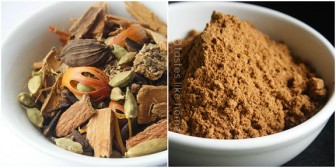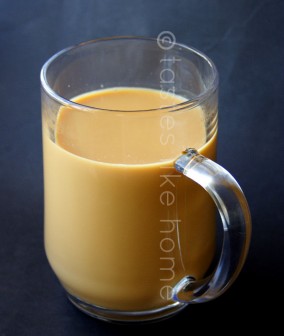Hi Everyone, My world of tea drinking took an exotic twist back in 2007 when friends from the Indian sub-continent introduced me to tea masala (masala chai).
Masala Chai is spiced tea (chai is the Hindi word for tea). In other words, it is a milky tea that is made with a blend of spices and sweetened with sugar. Most of us are familiar with some type of masala. The word (masala) itself refers to a mix of spices. Garam masala is the most popular type of masala in our part of the world; it is the spice blend we use to make various curries. There are many types of masalas, each combination best suited for various types of dishes with a range of ingredients, from meat to vegetables to legumes.

The history of masala chai goes back to thousands of years ago when it was created as an Ayurvedic beverage. Ayurveda is a Hindu system for traditional medicine. It is for this reason that the spice blends vary as the combination of spices used is supposed to cure particular ailments or conditions. However, these days, a lot of the tea masala blends are mostly based on taste, a family or individual preference.
Masala chai can be made with whole or ground spices. The tea of choice is usually a strong black tea, though the Kashmiri version of masala chai is made with green tea. The use of strong black tea is generally preferred because it is a rich robust tea that can stand up to the spice blend without either (tea or spices) over powering the other. The more traditional spices are cardamom (elaichi), cinnamon, cloves, ginger, peppercorns and anise seed. Other spices such as mace, nutmeg, allspice, star anise, fennel seeds, ajwain and dried bay leaves are added based on region, climate and individual tastes.
Depending on when and how you drink your tea – as a beverage of pleasure and relaxation, for digestion, or to break the fast (as in breakfast) – it is easy to understand why certain combination of spices are preferred in a masala chai mix: for example, the use of ginger to ease sore throats along with cold and flu symptoms, cloves to help promote circulation, cinnamon as a stimulant, cardamom to help ease indigestion and black pepper corns to promote healthy digestion.
Making Masala Chai

As I indicated earlier, masala chai can be made with either whole or ground spices. What I generally do is mix up the whole spices, toast and grind some and leave the rest whole. I use the whole spices when time is on my side to let the tealeaves, milk and spices simmer on the stovetop. I use the ground spice blend when I want a quick cup using a tea steeper or infuser with tealeaves or tea bags.
Just as the spice blend is unique to each home, so too is the art of making the tea. It is based on custom and tradition. A popular way to make masala chai with the whole spices is as follows:
Add equal amounts of water and whole milk, along with th tealeaves are then added and the mixture, brought to a boil on high heat and then ree whole spices and bringing the pot to a boil first and then reduce it to a gentle simmer for a few minutes (about 4 – 5 minutes). Themoved from the heat, the pot covered and the tea allowed to steep. Tea is then strained, sweetened and served!
If you’re going to use whole spices, they must be boiled with the water, milk and tealeaves mixture. On the other hand, if you are making masala chai using ground spices and say, tea bags, then add the tea bags and some of the spice powder mix to a warmed teapot or cup, pour in boiling water, cover and let steep. Sweeten with sugar and milk. Let the tea rest for about 30 seconds (the spices will settle) and then serve. The same directions uptake if using tea leaves.
Other Uses –
Masala Chai Mix
The grounded spice mix for masala chai can also be used for very many other things – syrups, cakes, sweet breads, buns, pastries, fruit pies, pancakes, scones, biscuits, jams, sweet chutneys, ice cream, coffee, custard and smoothies. Try adding it to your oats porridge or Cream of Wheat, so very good!

(with Assam tealeaves)
(Photo by Cynthia Nelson)
You don’t have to have a long list of spices to make spiced tea, you can also make a single-spice tea. Cardamom, anise seed, cinnamon, ginger and allspice all make for excellent single-spiced tea.
I make various masala chai blends for my tea but a couple that I make and use often I am sharing with you. I would suggest that you play around with some of the spices and come up with a combination that best suits your taste. If you like the flavour of cinnamon then let that be the predominant spice that you use (by quantity) and so on.
Cynthia’s Masala Chai Mix
(Whole Spices)
4 whole cardamom pods, crushed
2” piece cinnamon stick
2 whole cloves
2” thick slice fresh ginger
¼ teaspoon anise seeds
The above is for making tea – 2 cups water and 2 cups whole milk with 6 teaspoons strong black tea leaves.
Cynthia’s Masala Chai Mix
(Ground Spices)
2 teaspoons ground aniseed
1 teaspoon ground cinnamon
½ teaspoon ground cardamom seeds (black)
¼ teaspoon ground cardamom seeds (green)
¼ teaspoon ground ginger
¼ teaspoon ground black pepper
¼ teaspoon ground star anise
Add all the ingredients to a small bowl and mix thoroughly.
Use ½ teaspoon to 1 (8 – 10oz) cup of tea using 1 teabag.
Cynthia




